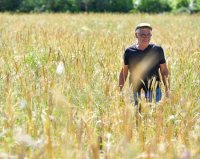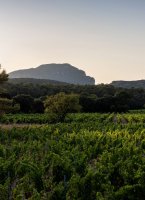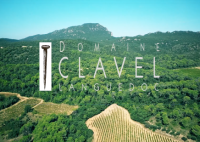The terroirs
“The vineyards are different than they were at the beginning. Nothing original here: life made them that way. And it suits us. Estelle and I are always seeking different ways of expression, new sensations and passions”. Change and expansion have shaped the landscape, which has evolved with their different projects, along with feelings, discoveries and the will to ensure their sons’ futures. Nothing is stable, nothing is permanent. Maybe this is what winemaking is all about! Estelle and Pierre love this perpetual motion, a sign of progression and evolution with a connection to the earth and the vine that grows on it. The limestone soil, which they find tough yet soft, is their connection.
The core
Mas de Périé
Mas de Périé is the core of it all, the remarkable entity where vineyards, olive groves, truffle oaks, gardening parcels and blooming fallow fields thrive. The latter not only embellish the landscape but also feed the bees living in the estate’s five hives. A haven and biotope strewn with heirloom varieties of soft wheat.
It is also the hub that brings together the vinification and aging cellar, the sales office, the visitor center, the tractor hangar, the coffee machine that warms and comforts us and the BBQ with the coals burning every other month for our staff feasts. The terroir is about human beings.
The estate is only 20 minutes from Montpellier.

The right exposure
The Pic Saint Loup vineyard
The soil can have charm for whoever handles it, feels it, observes it. Here, it is brown, red and yellow… Depending on what you are looking for…
In Saint-Jean-de-Cuculles, the vineyards are nestled in the heart of an Aleppo pine forest.
This forest is fragrant, with thyme and rosemary adding to the bouquet, which puts you in good spirits and makes working sweet.
Both parcels offer an ideal exposure, with one parcel in the plains and one parcel on the hillsides. The former is made of clay and small pebbles and the latter is made of screes and limestone colluvium. The 42-acre vineyard acquired in 2009 was organically farmed from the start. Six people work on it every day year-round. Thus, in a short amount of time, the landscape changed with hedgerows shooting up once again, vine-pruning made easier and a newly planted white wine vineyard. In order to improve the soil structure, mustard, peas and triticale are grown there in the winter and are flattened in the summer to create a protective mulch for a few weeks before plowing.
The Syrah grapes love those three different clays that I affectionately call yellow – as in blond, brown – as in brunette, and red – as in redhead. The brunette offers me small dense grape clusters with hints of black fruits and generous tannins. The blond flatters me with her floral perfume of lilies and irises. Finally, the redhead charms me with deliciously spiced loose clusters: the pinch of pepper that highlights the fruit of both cuvees made from this terroir: Bonne Pioche and Des Clous.

Between vineyards and fruit trees
The Montpeyroux vineyard
A rapid change of events took place. It was September 2016 and the harvest was in full swing. The Clavel’s caught wind of a vineyard for sale in Montpeyroux. Antoine went over to see. He came back enthusiastic and took his brother and parents there right away. It was a beautiful location, the grapes tasted good and a few olive trees grew among the vines. The air was cool and breezy, thanks to the Mediterranean/Atlantic climate barrier only 7 miles away, whereas the estate itself was over 25 miles away.
This small vineyard was nestled against the foothills of the Larzac overlooking the plain, standing 1150 feet high, the highest peak in Montpeyroux. It was surrounded by 30-year-old almond trees. The soil was calcareous. Very calcareous with 25 acres on a plateau of colluvial deposits. After being cleared 35 years ago, it was planted with Syrah grapes and has maintained its wild character.
Further down, an 8-acre parcel close to the village of Montpeyroux has devoted its hillside to the Mourvèdre grape and a handful of Carignan grapes. The site is a pleasure for the eyes with its gardens of vines and fruit trees.


